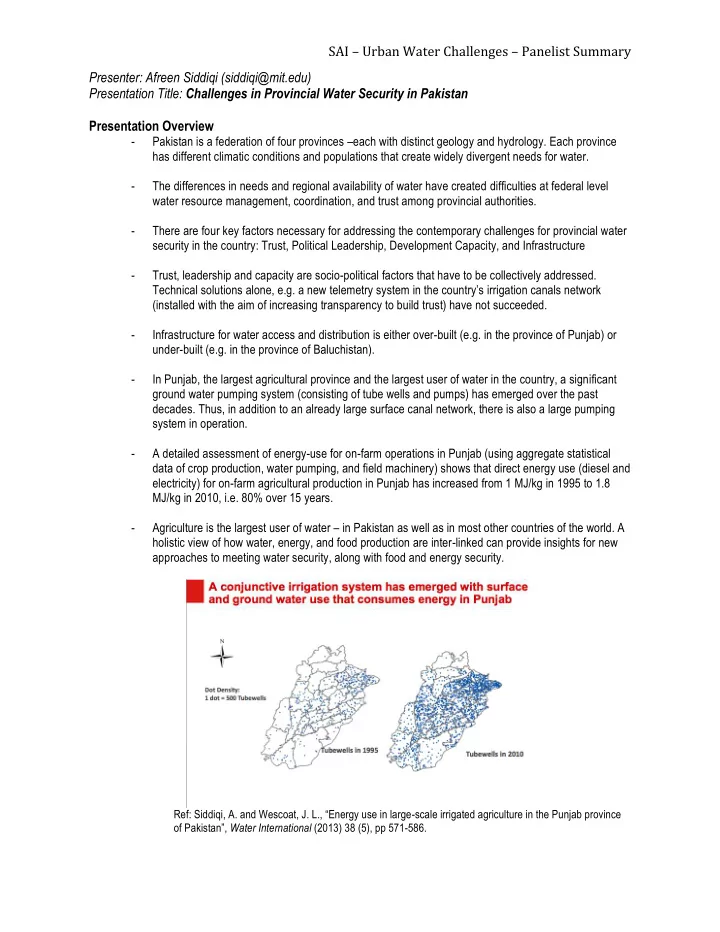

SAI ¡– ¡Urban ¡Water ¡Challenges ¡– ¡Panelist ¡Summary ¡ Presenter: Afreen Siddiqi (siddiqi@mit.edu) Presentation Title: Challenges in Provincial Water Security in Pakistan Presentation Overview - Pakistan is a federation of four provinces –each with distinct geology and hydrology. Each province has different climatic conditions and populations that create widely divergent needs for water. - The differences in needs and regional availability of water have created difficulties at federal level water resource management, coordination, and trust among provincial authorities. - There are four key factors necessary for addressing the contemporary challenges for provincial water security in the country: Trust, Political Leadership, Development Capacity, and Infrastructure - Trust, leadership and capacity are socio-political factors that have to be collectively addressed. Technical solutions alone, e.g. a new telemetry system in the country’s irrigation canals network (installed with the aim of increasing transparency to build trust) have not succeeded. - Infrastructure for water access and distribution is either over-built (e.g. in the province of Punjab) or under-built (e.g. in the province of Baluchistan). - In Punjab, the largest agricultural province and the largest user of water in the country, a significant ground water pumping system (consisting of tube wells and pumps) has emerged over the past decades. Thus, in addition to an already large surface canal network, there is also a large pumping system in operation. - A detailed assessment of energy-use for on-farm operations in Punjab (using aggregate statistical data of crop production, water pumping, and field machinery) shows that direct energy use (diesel and electricity) for on-farm agricultural production in Punjab has increased from 1 MJ/kg in 1995 to 1.8 MJ/kg in 2010, i.e. 80% over 15 years. - Agriculture is the largest user of water – in Pakistan as well as in most other countries of the world. A holistic view of how water, energy, and food production are inter-linked can provide insights for new approaches to meeting water security, along with food and energy security. Ref: Siddiqi, A. and Wescoat, J. L., “Energy use in large-scale irrigated agriculture in the Punjab province of Pakistan”, Water International (2013) 38 (5), pp 571-586.
SAI ¡– ¡Urban ¡Water ¡Challenges ¡– ¡Panelist ¡Summary ¡ Ref: Siddiqi, A. and Wescoat, J. L., “Energy use in large-scale irrigated agriculture in the Punjab province of Pakistan”, Water International (2013) 38 (5), pp 571-586. Key Questions/ Challenges Identified - Mega-cities in South Asia have unique challenges related to water. A diagnostic approach needs to be developed that helps identify the key factors (social, political, technical, environmental) affecting water access and availability for a particular urban area. Development of rigorous diagnostic methodologies will be an important first step towards finding sustainable solutions by identifying what the real problems are (that may well be different from apparent problems). - Agriculture is the largest user of water, and any future reallocation of water from agricultural sector to cities for municipal use will require provincial/state level intervention and action. Suggested Solutions and Pathways - The socio-political issues that lead to water scarcity, should be investigated with contemporary knowledge and research on negotiations, trust building, game-theory, and political science. - Approaches and methods that have been developed to study complex socio-technical systems, such as stakeholders analysis, systems dynamics, networks and graph theory etc. provide new approaches for studying problems of water access and availability. - A key step forward is to un-pack the inter-dependencies between water, food, and energy. The so- called water-energy-food nexus should be investigated, identified, quantified, and used as a means for finding sustainable solutions that jointly address the inter-connected issues of water, food, and energy security at different scales. Some water problems may be solved through manipulating levers in other connected systems, and leveraging indirect connections can provide and new and powerful ways of addressing old problems.
SAI ¡– ¡Urban ¡Water ¡Challenges ¡– ¡Panelist ¡Summary ¡ Key References - Siddiqi, A. and Wescoat, J. L., “Energy use in large-scale irrigated agriculture in the Punjab province of Pakistan”, Water International (2013) 38 (5), pp 571-586 - Siddiqi, et. al, “An empirical analysis of the hydropower portfolio in Pakistan” , Energy Policy , Vol. 50, 2012 - Briscoe, J. and Qamar, U., “Pakistan’s Water Economy Running Dry”, Oxford University Press, 2005. - Mustafa, D., “Hydropolitics in Pakistan’s Indus Basin”, Special Report, SR261, United States Institute of Peace.
Recommend
More recommend